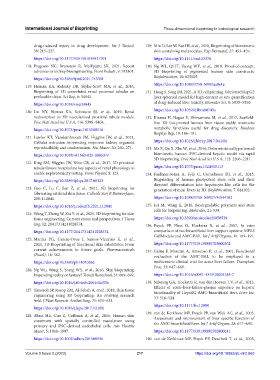Page 225 - IJB-9-2
P. 225
International Journal of Bioprinting Three-dimensional bioprinting in toxicological research
drug-induced injury in drug development. Int J Toxicol, 129. Min D, Lee W, Bae IH, et al., 2018, Bioprinting of biomimetic
38: 215–227. skin containing melanocytes. Exp Dermatol, 27: 453–459.
https://doi.org/10.1177/1091581819831701 https://doi.org/10.1111/exd.13376
118. Pregosin NC, Bronstein R, Mallipattu SK, 2021, Recent 130. Ng WL, Qi JT, Yeong WY, et al., 2018, Proof-of-concept:
advances in kidney bioengineering. Front Pediatr, 9: 743301. 3D bioprinting of pigmented human skin constructs.
https://doi.org/10.3389/fped.2021.743301 Biofabrication, 10: 025005.
119. Homan KA, Kolesky DB, Skylar-Scott MA, et al., 2016, https://doi.org/10.1088/1758-5090/aa9e1e
Bioprinting of 3D convoluted renal proximal tubules on 131. Hong S, Song JM, 2021, A 3D cell printing-fabricated HepG2
perfusable chips. Sci Rep, 6: 34845. liver spheroid model for high-content in situ quantification
of drug-induced liver toxicity. Biomater Sci, 9: 5939–5950.
https://doi.org/10.1038/srep34845
120. Lin NY, Homan KA, Robinson SS, et al., 2019, Renal https://doi.org/10.1039/d1bm00749a
reabsorption in 3D vascularized proximal tubule models. 132. Kizawa H, Nagao E, Shimamura M, et al., 2017, Scaffold-
Proc Natl Acad Sci U S A, 116: 5399–5404. free 3D bio-printed human liver tissue stably maintains
https://doi.org/10.1073/pnas.1815208116 metabolic functions useful for drug discovery. Biochem
Biophys Rep, 10: 186–191.
121. Lawlor KT, Vanslambrouck JM, Higgins JW, et al., 2021,
Cellular extrusion bioprinting improves kidney organoid https://doi.org/10.1016/j.bbrep.2017.04.004
reproducibility and conformation. Nat Mater, 20: 260–271. 133. Ma X, Qu X, Zhu W, et al., 2016, Deterministically patterned
https://doi.org/10.1038/s41563-020-00853-9 biomimetic human iPSC-derived hepatic model via rapid
3D bioprinting. Proc Natl Acad Sci U S A, 113: 2206–2211.
122. King SM, Higgins JW, Nino CR, et al., 2017, 3D proximal
tubule tissues recapitulate key aspects of renal physiology to https://doi.org/10.1073/pnas.1524510113
enable nephrotoxicity testing. Front Physiol, 8: 123. 134. Faulkner-Jones A, Fyfe C, Cornelissen DJ, et al., 2015,
https://doi.org/10.3389/fphys.2017.00123 Bioprinting of human pluripotent stem cells and their
directed differentiation into hepatocyte-like cells for the
123. Gao C, Lu C, Jian Z, et al., 2021, 3D bioprinting for generation of mini-livers in 3D. Biofabrication, 7: 044102.
fabricating artificial skin tissue. Colloids Surf B Biointerfaces,
208: 112041. https://doi.org/10.1088/1758-5090/7/4/044102
https://doi.org/10.1016/j.colsurfb.2021.112041 135. Lei M, Wang X, 2016, Biodegradable polymers and stem
cells for bioprinting. Molecules, 21: 539.
124. Weng T, Zhang W, Xia Y, et al., 2021, 3D bioprinting for skin
tissue engineering: Current status and perspectives. J Tissue https://doi.org/10.3390/molecules21050539
Eng, 12: 20417314211028574. 136. Poyck PP, Pless G, Hoekstra R, et al., 2007, In vitro
https://doi.org/10.1177/20417314211028574 comparison of two bioartificial liver support systems: MELS
CellModule and AMC-BAL. Int J Artif Organs, 30: 183–191.
125. Manita PG, Garcia-Orue I, Santos-Vizcaino E, et al.,
2021, 3D Bioprinting of functional skin substitutes: From https://doi.org/10.1177/039139880703000302
current achievements to future goals. Pharmaceuticals 137. Calise F, Mancini A, Amoroso P, et al., 2001, Functional
(Basel), 14: 362. evaluation of the AMC-BAL to be employed in a
https://doi.org/10.3390/ph14040362 multicentric clinical trial for acute liver failure. Transplant
Proc, 33: 647–649.
126. Ng WL, Wang S, Yeong WY, et al., 2016, Skin bioprinting:
Impending reality or fantasy? Trends Biotechnol, 34: 689–699. https://doi.org/10.1016/s0041-1345(00)02183-7
https://doi.org/10.1016/j.tibtech.2016.04.006 138. Nibourg GA, Hoekstra R, van der Hoeven TV, et al., 2013,
Effects of acute-liver-failure-plasma exposure on hepatic
127. Tarassoli SP, Jessop ZM, Al-Sabah A, et al., 2018, Skin tissue functionality of HepaRG-AMC-bioartificial liver. Liver Int,
engineering using 3D bioprinting: An evolving research 33: 516–524.
field. J Plast Reconstr Aesthet Surg, 71: 615–623.
https://doi.org/10.1111/liv.12090
https://doi.org/10.1016/j.bjps.2017.12.006
139. van de Kerkhove MP, Poyck PP, van Wijk AC, et al., 2005,
128. Abaci HE, Guo Z, Coffman A, et al., 2016, Human skin Assessment and improvement of liver specific function of
constructs with spatially controlled vasculature using
primary and iPSC-derived endothelial cells. Adv Healthc the AMC-bioartificial liver. Int J Artif Organs, 28: 617–630.
Mater, 5: 1800–1807. https://doi.org/10.1177/039139880502800611
https://doi.org/10.1002/adhm.201500936 140. van de Kerkhove MP, Poyck PP, Deurholt T, et al., 2005,
Volume 9 Issue 2 (2023) 217 https://doi.org/10.18063/ijb.v9i2.663

